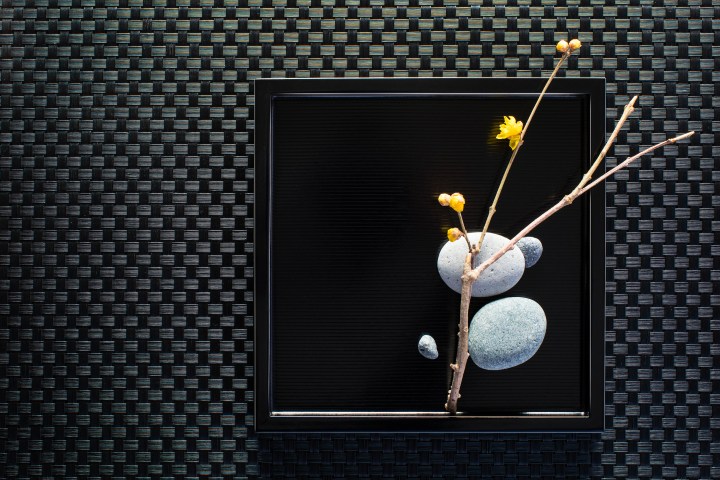How To Use Meditation to Boost Creativity

It is a well-known fact that meditation and mindfulness can be used to create feelings of calm and relaxation. But an unexpected benefit of meditation is that it can also boost your creativity.
This is because when the mind becomes a little calmer it allows your quieter and more creative voice to rise above the background noise. Secondly, broadening awareness enhances working memory and gives you greater insight into the world around you. This increases the likelihood of putting ideas together and having a moment of creative insight.
This article will present you with two guided meditations specifically designed to help clear your mind and encourage creative thoughts. The first is a simple breathing exercise, and the second is the Sounds and Thoughts meditation.
As the name suggests, the Sounds and Thoughts meditation reveals the similarities between sounds and thoughts. It teaches you that you can relate to your thoughts in the same way that you do to sounds. Both arrive seemingly from nowhere. You have no control over their arising or their content. Both carry powerful messages that seemingly compel you into action. In a sense, just as the ear is the organ that receives sounds, the mind is the organ that perceives thoughts. And once you grasp this similarity you can begin to see that ‘loud’, insistent, habitual thoughts – like sounds – are the ‘noise’ that clouds creative insight. If you can soothe the mind, so that your thoughts are less habitual, frenetic and fevered, then you can begin to ‘hear’ the quieter thoughts that often convey deeper and more creative insights.
The Sounds and Thoughts meditation works on many levels simultaneously:
- Firstly, it calms the mind so that your quieter and more creative voice can rise above the background noise.
- Secondly, by teaching you to pay attention to your thoughts, it gradually enables you to notice novel and interesting thoughts and ideas as soon as they arise.
- Thirdly, it teaches you how to effortlessly shift the focus of your awareness and style of thinking. In essence, you learn how to ‘flick’ between thoughts in the same way that you do with sounds. It’s analogous to the ‘cocktail- party effect’, whereby you can hear your name mentioned by a person on the other side of a noisy room even though the volume of their voice is well below that of the general background hubbub. Being able to shift the focus of your awareness in this way greatly enhances mental flexibility and clarity of thought.
- Fourthly, it enhances working memory and puts problems in context by increasing the depth and breadth of your awareness. This weakens the hold that habitual thought patterns, emotions and associations have over you.
- Fifthly, it allows your deep subconscious to more effectively process information, reformulate problems, capture the essence of an idea and conjure up solutions.
Breathing meditation
- Sit upright in a straight-backed chair. Your spine should be allowed to adopt its natural shape in a relaxed but dignified posture about an inch from the back of the chair. Place your hands in your lap in whatever position feels the most comfortable. You can also do this meditation lying down, standing or even walking. The guidance assumes that you are sitting, but you can adapt the instructions as you go along to whatever posture you’ve chosen.
- Allow your body to settle down into gravity, letting it be held and supported by the chair beneath you.
- Gently close your eyes. Begin by tuning into the world around you. It might be noisy inside or out. You might hear cars, wind, rain or human voices. Whatever is here, pay attention to the sounds for a moment. Try to remain receptive to them, rather than being drawn into them. Notice how they rise and fall. Try not to change anything. Simply listen to this constantly changing landscape of sounds for a few moments.
- Gather up your awareness and focus your attention on your feet. Can you feel the floor beneath them? Do they feel warm or cold? Or perhaps tingly or a little achy? Pay attention to the sensations themselves. Consciously feel them, rather than think about them. Notice how the actual sensations rise and fall. If there are no sensations at all, then simply acknowledge this to yourself.
- Now gently move your awareness through your whole body and feel the sensations in a similar way. How do your legs feel? Pause for a moment to soak up the sensations. Then slowly move your awareness to your pelvis, then your stomach and lower back . . . your chest and upper back . . . feel the rise and fall of the breath for a few moments.
- And how do your arms feel? Move your awareness to your shoulders and pause for a few moments. Then move on to your neck and head. How do they feel?
- Pause here for a minute or so while you soak up the sensations of your whole body. Feel its pulsating life as the different sensations rise and fall. Try not to change anything at all. Simply accept what you find.
- Allow your awareness to gather around the sensations of the breath in your body. Where do you feel the breath most strongly? The stomach? Ribs? Shoulders? Nose? Or perhaps the throat? Be curious about the actual experience. Try to accept the experience for what it is, rather than having any expectations or judgments. Accept whatever you find.
- Very gently rest your awareness within the whole torso. Can you feel your stomach rising on the in- breath and falling on the out- breath? Can you feel any movement and sensations in the sides of the body? In the back of the body? Try to bring a sense of kindly curiosity towards whatever you are experiencing as you breathe. Remember to accept whatever is happening as you breathe. Become aware of the qualities of your breaths. Are they fast or slow? Shallow or laboured? Smooth or ragged? See if you can cultivate a precise awareness of the sensations and movement of the breath in the body as they happen, moment by moment, being careful not to force or strain any of them. In this way, follow the breath as it rocks and cradles the body for a couple of minutes.
- From time to time your mind will wander. This is normal. Each time it happens, gently acknowledge where your mind went, then bring your awareness back to wherever the sensations of breathing are the strongest.
- When your mind wanders again, as it surely will, become aware of any thoughts and emotions. As best you can, try not to criticise or judge them in any way. Try not to clear your mind of thoughts. Meditation isn’t about having a blank or empty mind. It’s normal to think. It’s what minds do. So instead, can you look ‘at’ your thoughts and emotions, rather than ‘from’ them? Can you get a sense of being aware of what you are thinking and feeling without either blocking your experience on the one hand or getting lost or overwhelmed by it on the other?
- Try to remember that thoughts are not facts – even those that claim to be. Can you let go of being caught up in them? Notice how they’re continually changing one moment to the next in exactly the same way that your breath always changes. They’re not as fixed and solid as you perhaps thought.
- Each time that your mind becomes caught up ‘inside’ your thoughts and emotions gently acknowledge them by silently saying to yourself, ‘Thinking, thinking’, ‘Worrying, worrying’ or whatever feels most appropriate. Then return your attention to the rise and fall of the breath. Use it as an anchor for the mind over and over again. Follow the breath all the way in and all the way out. And each time your awareness wanders, as it will, simply note it and return to the breath – time after time after time. Be very kind and patient with yourself. Realising that your mind has wandered is the meditation. This is a magic moment of awareness: a moment when you’ve woken up from a distraction. So when you realise that your mind has wandered, you’re succeeding in the practice, not failing; just as you are succeeding when you manage to stay with the breath.
- Focus your awareness on the breath in this way for a few minutes more.
- Gently bring the meditation to a close. What sounds can you hear around you? Sounds near, sounds far. Are there any aromas? Can you feel anything unusual about your body? Stiffness, perhaps? Or the feel of clothes on your skin? Gently open your eyes and soak up whatever is in your line of sight. Gradually, gently, begin to move, making sure you give yourself time to make a smooth transition from the meditation to whatever you’re doing next.
Sounds and Thoughts meditation
If you are doing this meditation at home or at work, then it is preferable to sit upright in a straight- backed chair. If you are doing it in a public place, find somewhere to sit where you are upright and your back is self- supporting. A park bench is ideal. You can also adapt this meditation and carry it out on buses, trains or aircraft.
- Begin by gently closing your eyes. Spend a few moments allowing your head, neck and shoulders to relax.
- Gather up your awareness and begin to focus on the movements of the breath in your body. When you feel settled, gradually expand your awareness to include your whole body. Can you sense your whole body breathing? Spend a minute or so focusing on the movements of the breath in the body as if you were practising the Breathing meditation.
- Expand your awareness to include any sounds that surround you. Be open to them. There is no need to actively seek them out. As best you can, simply be open and receptive to them as they arrive. You might notice the sound of a television, air- conditioning, music or perhaps people talking. You might hear cars, trains or aircraft in the distance, or perhaps the sound of wind, rain or birdsong. The ‘soundscape’ has enormous depth and variety. Become aware of whatever is here.
- Notice as the sounds arrive from all directions: from the front or back, above or below, from the left or right, sounds near, sounds far. See if you can sense their arrival, how they linger, and then slowly fade away. You have no control over their arrival or departure, or how long they stay.
- As best you can, be aware of sounds as sounds, as raw sensations. Notice the tendency to label sounds such as ‘car’, ‘wind’ or ‘siren’. See if it is possible to notice this labelling, and then to refocus your awareness on the sounds themselves, on the raw sensations.
- Pay attention to the qualities of the sounds: to the way they rise and fall, to their pitch and timbre. See if you can notice how the louder or more obvious sounds tend to ‘crowd out’ the quieter ones.
- Notice the gaps between the sounds. Can you gain a sense of the silence? You might notice that this silence is relative. Even silence may contain very subtle, quiet sounds on the edge of hearing. If you are in a very quiet place, you might be able to hear your breath, your heart or perhaps the rush of blood through your inner ears. Be open to them all.
- As best you can, try to avoid becoming drawn into any individual sounds. You might find yourself thinking about sounds. When this happens, simply acknowledge where your mind has wandered to, and gently bring your awareness back to the sounds as they rise and pass away.
- Focus your awareness on the soundscape in this way for three or four minutes.
- Gently shift the focus of your awareness to your thoughts. Notice how thoughts arise in the mind, linger for a while and then dissolve. Just as with sounds, you have no control over their arriving or leaving, so there is no need to try to make thoughts come or go. Just as with sounds, you cannot control the type or intensity of thoughts flowing across your mind. All you can do is be aware of them. As best you can, see thoughts as events in the mind. See if you can relate to them in the same way that you do to sounds.
- Thoughts can be likened to clouds in the sky. Sometimes they are dark and stormy; at other times they may be soft and wispy. Sometimes they fill the entire sky, while at others they dissolve completely, leaving it clear and empty.
- If powerfully charged thoughts or emotions should arise, pay kindly attention to them, and allow them to be just as they are. Just like sounds – or clouds in the sky – they will eventually change or disappear completely.
- If you should begin to feel lost in your thoughts, as if your mind has become unfocused and scattered, then gently bring the focus of your awareness back to the breath. Feel the sensations of breathing for three or four breaths, then gently return to the thoughts flowing across your mind.
- In this way, continue paying attention to your thoughts for three or four minutes.
- Gently bring this meditation to a close. What can you hear? What can you smell? What can you feel on your skin? Sunlight perhaps? Or maybe the wind? Or perhaps clothes on your skin? Gently open your eyes and soak up whatever is in your line of sight. Gradually, gently, begin to move, making sure you give yourself enough time to make a smooth transition from the meditation to whatever you’re doing next.
Each meditation takes about ten minutes. It is best to carry out both of these meditations on six days out of the next seven, and at different times of the day. It’s entirely up to you when you do them, although most people tend to do the Breathing meditation in the morning and the Sounds and Thoughts meditation in the evening.
Work deadlines, to-do lists, family commitments, pressure to perform... Our frantic lives demand so much from us that we can often feel locked into a cycle of frustration, anxiety and stress, unable to tackle the tasks before us or see a way out of our habitual ways of thinking and doing things. Yet there is a way out. The simple mindfulness techniques at the heart of this book can help us lead a more creative and productive life - one that is isn't governed by the chaotic pace of life. They also dissolve anxiety, stress and depression while enhancing mental resilience. The four week programme takes just 10-20 minutes per day.
The easy-to-follow programme works by soothing and clearing your mind, allowing innovative ideas to take form and crystallise. This helps you to spontaneously 'see' the solution to a problem, to conjure up new ideas, or to create works that have true insight and flair. The programme helps build the courage necessary for you to follow your ideas wherever they should lead - and the resilience to cope with any setbacks. It will help your mind work more effectively so that you canlive more intuitively and have the inner confidence to drive your ideas forward.
The accompanying download link contains 6 meditations that you can use to build an ongoing practice, mixing and matching meditations to suit your circumstances








